You are here
Lepturinae
Lepturinae Latreille, 1804
Nomenclature
SUMMARY
Use the drop-down menu on the left to find information specific to each tribe, genus and species in the PNW. Pages contain keys, descriptions, images, references, and specimen-level data.
The Subfamiliy Lepturinae
The lepturines are one of the more commonly-encountered and recognizable subfamilies of cerambycid longhorn beetles. Lepturines are commonly called "the flower-visiting longhorn beetles," because, unlike the majority of species in the 9 subfamilies of Cerambycidae, adult lepturines tend to feed on flowers during the day time. Although this habit has apparently evolved several times among the 35,000+ species of longhorn beetles, particularly in the subfamilies Lamiinae and Cerambycinae, the majority of longhorn beetles are nocturnal.
Identification
The Lepturinae can be distinguished from other cerambycoids by the characteristics given below (based on Linsley and Chemsak, 1962 and 1972). To identify a specimen to species, proceed to the Identification page.
(1) Tarsi padded beneath and pseudotetramerous--the fourth of five tarsomeres highly reduced and hidden within an expanded, bi-lobed third tarsomere (in Parandrinae and Spondylinae the tarsi are lacking ventral pads and distinctly pentamerous, or five-segmented).
(2) Head directed forward, rarely sub-verticle (the head in Lamiinae is often vertical or retracted with the genal margins always directed posteriorly).
(3) Antennae capable of laying backwards over the body and usually extending past the posterior margin ("base") of the pronotum (antennae shorter in Parandrinae and Spondylinae). The second segment as broad, or broader than long (longer than broad in Aseminae).
(4) Pronotum either smooth or with pronounced tubercles laterally, but never with an elevated lateral margin (as in Prioninae).
(5) Stridulatory plate on mesonotum divided longitudinally by a thin vitta, or line (except the tribe Xylosteini); the mesonotum is also divided in Aseminae, but undivided in Cerambycinae and Necydalinae.
(6) Elytra usually extending the length of abdomen (abbreviated in Necydalinae).
(7) Mandibles often with a molar tooth, and (except tribe Desmocerini) densely fringed with pubescence on the inner margin. (Subfamily Aseminae lacks molar tooth).
(8) Wings with or without a closed cell in the anal sector (never present in Cerambycinae), vein 1A connected with 2A1+2. (2A2 is absent in Prioninae, and in Cerambycinae either 2A1, or 2A1 and 2A2 is absent).
Note. Following Lawrence and Newton (1995), Necydalinae is here treated as a separate subfamily from Lepturinae. Linsley and Chemsak (1972) treated the group within Lepturinae as the tribe Necydalini.
Size and Distribution
The group presently comprises around 1000 species (Bousquet et al., 2017) which are mostly distributed in the Northern Hemisphere, with many North American genera and species having close counterparts in Europe and Asia. A number of species also occur in South America (122 spp) and the Caribbean (4 spp.). Although the mainland African continent appears to be almost entirely devoid of lepturines, Madagascar hosts a highly distinctive endemic lepturine fauna with 141 species in 43 genera. At the extreme of its range in the eastern hemisphere, 44 species are currently known from Borneo (Heffern, 2005), several of which are undescribed. A similar, though less speciose fauna is also present in the Philippines. However to the east of the so-called "Wallace line" lepturines are suddenly absent, with just a single species known from New Guinea and none from Australia.
Biology and Taxonomy
Bibliographies and discussions on the taxonomic history and biology, physiology and ecology of lepturines can be found by on separate pages of this website. These pages also include references to literature on Pacific Northwestern lepturines that has appeared since the authoritative revision by Linsley and Chemsak (1972; 1976)
Phylogenetic Position of the Lepturinae
The most comprehensive phylogenetic analysis including Lepturinae was completed as a Bacchelor's Thesis (Bc.) written in Czechoslovakian by Miroslava Sýkorová (2008).
The Tribes of Lepturinae
The designation of tribal groups among the over 300 lepturine genera worldwide is a difficult an ongoing task. Often genera can be found which appear to possess a mixture of the traits from two well-defined tribal groups. The phenomenon of convergent evolution--or the independent development of traits through adaptation to similar habitats, rather than by shared ancestry, appears to be prevalent in the Lepturinae due to the particular selective forces relevant to life on flowers. For example, it appears likely that the bee-like black and yellow elytral patterning exhibited by such genera as Judolia and Xestoleptura has probably developed independently multiple times among lepturine genera, presumably in response to predation. Finally, the observation that classification schemes inferred solely from the examination of lepturine larval characters can yield widely different results from those based on adults (e.g., Craighead, 1923, vs. Swain and Hopping, 1928) suggests that a robust tribal classification and phylogenetic hypothesis of the world lepturines is still a ways off, and will likely require the elaboration of additional character sets, particularly those of the genitalia (Ehara, 1954; Fragoso, 1985; Hubweber and Schmitt, 2010), as well as genetic tools.
Nine tribal names within Lepturinae were recognized as validly designated and available by Bosquet et al. (2009) and Bouchard et al. (2011). The tribes as they are typically recognized vary in size from over 130 genera in the Lepturini, and around 45 genera in Rhagiini, to several "monotypic" tribes, each containing only a single atypical genus. In assigning our Pacific Northwestern fauna to tribes, I have attempted to bridge the differences between the traditional North American system based on Linsley and Chemsak (1972; 1976), and the more recent systems proposed by workers studying the European and Asian faunas. These latter regions, collectively referred to as "the Palearctic," contain the bulk of the world lepturine diversity. Many of our North American genera have affinities to these Palearctic species which have only very recently begun to be recognized.
Desmocerini Blanchard, 1845:
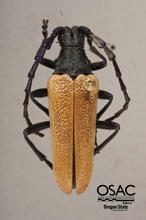
Encylopini LeConte, 1873:
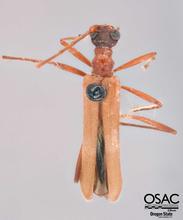
Lepturini Latreille, 1802:
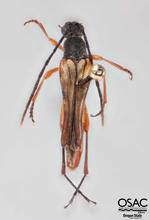



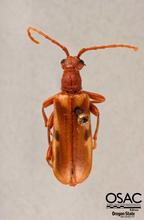
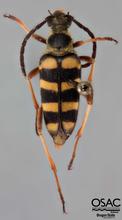
Oxymirini Danilevsky, 1997:
Rhamnusiini Sama, 2009:

Rhagiini Kirby, 1837:



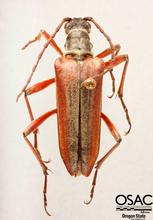


Xylosteini Reitter, 1913:

References
- Blanchard, C.E. 1845. Histoire des insectes, traitant de leurs moeurs et de leurs métamorphoses en général, et comprenant une nouvelle classification fondée sur leurs rapports naturels. 2:163. http://archive.org/details/histoirenaturell02blan
- Bouchard, P., Bousquet, Y., Davies, A.E., Alonso-Zarazaga, M.A., Lawrence, J.F., Lyal, C.H.C., Newton, A.F., Reid, C.A.M., Schmitt, M., Ślipiński, S.A., and Smith, A.B.T. (2011). "Family-Group Names in Coleoptera (Insecta).", ZooKeys, 88, pp. 1-972. doi : 10.3897/zookeys.88.807
- Bousquet Y, Heffern DJ, Bouchard P, Nearns EH. 2009. Catalogue of family-group names in Cerambycidae (Coleoptera). Zootaxa 2321: 1–80. (22 Dec 2009).
- Bousquet Y., Laplante S., Hammond H.E.J. & Langor D.W. 2017. Cerambycidae (Coleoptera) of Canada and Alaska: identification guide with nomenclatural, taxonomic, distributional, host-plant, and ecological data. Prague, Nakladatelství Jan Farkač, 300 pages.
- Craighead, F. C. 1923. North American cerambycid larvae. A classification and the biology of North American cerambycid larvae. Canada Department of Agricultue, Bulletin (new series) 27:1–239.
- Danilevsky ML (1997) [new taxa] In: Althoff J, Danilevsky ML: Seznam kozličev (Coleoptera, Cerambycoidea) Europe. A check-list of longicorn beetles (Coleoptera, Cerambycoidea) of Europe. Slovensko Entomološko Društvo Štefana Michielija, Ljubljana, 64 pp.
- Danilevsky, M. L. 2013. Systematic list of Longicorn Beetles (Cerambycoidea) of the territory of the former USSR, http://www.cerambycidae.net/ (Accessed June 6, 2013).
- Ehara, S. 1954. Comparative Anatomy of Male Genitalia in Some Cerambycid Beetles (With 199 Text-figures). Journal of the faculty of science Hokkaido University Series 6/Zoology, 12(1-2): 61-115.
- Fragoso, S.A. 1985. The terminalia as a basis for the classification of Cerambycidae (Coleoptera) subfamilies. Part I Terminology and genital morphology of Cerambyx cerdo L. Rev Bras Entomol 29:125–134
- Heffern, Daniel J. 2005. Catalog and Bibliography of Longhorned Beetles from Borneo (Coleoptera: Cerambycidae). Electronic Version. 2005.1.
- Hubweber L. and Schmitt M. (2010). Differences in genitalia structure and function between subfamilies of longhorn beetles (Coleoptera: Cerambycidae). Genetica. 2010 Jan; 138(1):37-43. doi: 10.1007/s10709-009-9403-x.
- Kirby, W. 1837. The Insects. Coleoptera. In J. Richardson, W. Swainson, and W. Kirby, Fauna Boreali Americana; or the Zoology of the Northern Parts of British America: containing descriptions of the objects of natural history collected on the Late Northern Land Expedition, under the command of Captain Sir John Franklis, R. N. Norwich, Josiah Fletcher. 249 pp.
- Latreille, P. A. 1802. Histoire naturelle, générale et particulière des crustacés et des insectes. Ouvrage faisant suite à l’histoire naturelle générale et particulière, composée par Leclerc de Buffon, et rédigée par C.S. Sonnini, membre de plusieurs sociétés savantes. Familles naturelles des genres. Tome troisième. F. Dufart, Paris, xii + 13–467 + [1] pp. [An X (title page, =1802); Nov 1802 (Evenhuis 1997)]
- Lawrence JF, Newton AF Jr (1995) Families and subfamilies of Coleoptera (with selected genera, notes, references and data on family-group names). In: Pakaluk J, Slipinski SA (eds) Biology, phylogeny, and classification of Coleoptera. Papers celebrating the 80th birthday of Roy A Crowson, vol 2. Muzeum i Instytut Zoologii PAN, Warszawa, pp 779–1006.
- LeConte, J. L. 1873. Classification of the Coleoptera of North America. Prepared for the Smithsonian Institution. Part II. Smithsonian Miscellaneous Collections. 11(265):279-348. Link to BHL.
- Linsley, E.G. 1962. The Cerambycidae of North America. Part II. Taxonomy and classifcation of the Parandrinae, Prioninae, Spondylinae and Aseminae. Univ. Calif. Publs Ent., Berkeley, 19: 1-102, 34 figs, 1 pl.
- Linsley, E. G., and J. A. Chemsak. 1972. Cerambycidae of North America. Part VI. No. 1. Taxonomy and Classification of the Subfamily Lepturinae. University of California Publications in Entomology 69, xiii+138 pp, 2 pl.
- Linsley, E.G. and J.A. Chemsak. 1976. Cerambycidae of North America. Part VI, No.2. Taxonomy and Classification of the Subfamily Lepturinae. University of California Publications in Entomology 80, 186 pp.
- Reitter E (1913) Fauna Germanica. Die Käfer des Deutschen Reiches. Nach der analytischen Methode bearbeitet. IV. Band. K. G. Lutz, Stuttgart, 236 pp. + pls. 129–152. [1912 (title page); 1913 (Zool. Record; Arch. Naturg. 80B); Feb 1914 (Ent. Litteraturbl.); 1 Mar 1914 (Ent. Bericht. 4 (76): 62)].
- Sama, G. & Sudre, J. (2009) New nomenclatural acts in Cerambycidae. II. (Coleoptera). Bulletin de la Société Entomologique de France, 114(3), 383–388.
- Sýkorová, M. 2008. Molecular phylogeny of the subfamilies Spondylidinae and Lepturinae (Coleoptera: Cerambycidae) based on mitochondrial 16S rDNA. Bachelor’s thesis, Faculty of Natural Sciences, South Bohemian University, Ceske Budejovice.
- Swaine, J. M. & R. Hopping. 1928. The Lepturini of America North of Mexico. Part I. Bull. Nat. Mus. Canada, (Biol. Serv.) (14)52:1-97, 13 pls.



